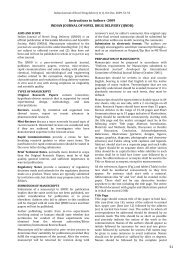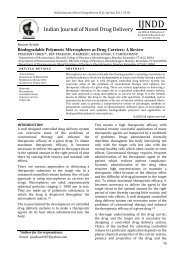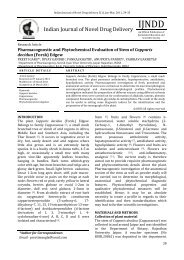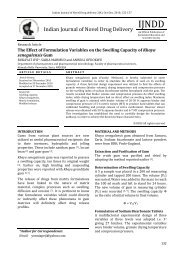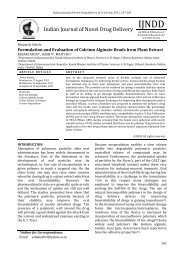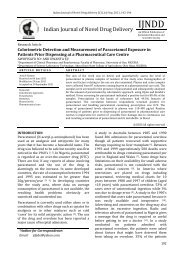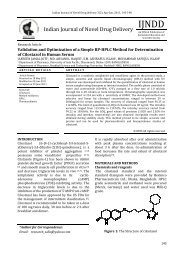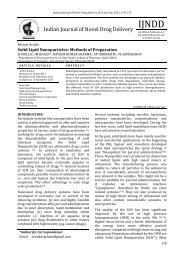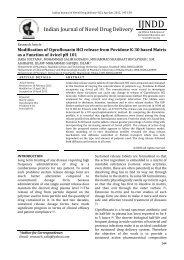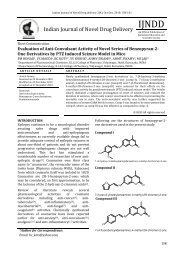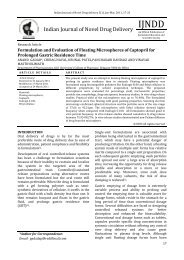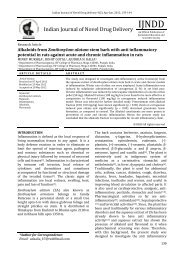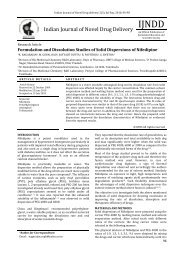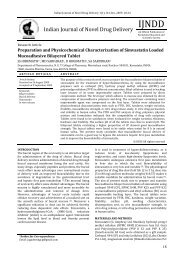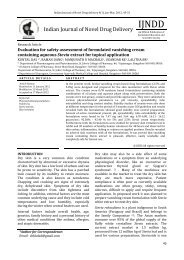Physicochemical Characterization of Acacia Sieberiania Gum
Physicochemical Characterization of Acacia Sieberiania Gum
Physicochemical Characterization of Acacia Sieberiania Gum
Create successful ePaper yourself
Turn your PDF publications into a flip-book with our unique Google optimized e-Paper software.
AR Oyi et al / Indian Journal <strong>of</strong> Novel Drug Delivery Jul-Sep, 2010, 99-102<br />
Determination <strong>of</strong> Bulk and Tapped Densities<br />
Bulk and tapped densities were determined by modified<br />
method 7 . Sixty grams (60 g) <strong>of</strong> the acacia gum powder<br />
was weighed and transferred into a 100ml measuring<br />
cylinder the volume (Vb) was recorded as bulk volume.<br />
The total weight <strong>of</strong> the powder and cylinder was noted.<br />
The bottom <strong>of</strong> the cylinder was raised 17cms above the<br />
slab and made to fall on the platform continuously for<br />
100 taps. The volume (Vt) <strong>of</strong> the powder was recorded<br />
and this represents the volume <strong>of</strong> gum minus the voids<br />
and is called the tapped volume.<br />
Bulk density = 60/Vb ---------------------------------2<br />
Tapped density = 60/Vt ----------------------------- 3<br />
Angle <strong>of</strong> repose<br />
Angle <strong>of</strong> repose was determined as the tangent <strong>of</strong> the<br />
cone formed by powder heap. The height was divided<br />
by the radius formed by powder on passing through a<br />
funnel orifice to the horizontal 8 .<br />
Flow rate<br />
Thirty grams (30g) weight (w) <strong>of</strong> the gum powder was<br />
placed in the Erweka flow tester apparatus and allowed<br />
to flow through the formed orifice. The time taken (t) for<br />
all the powder to completely flow out was noted and<br />
flow rate was computed from;<br />
w/t ---------------------------------------------------- 4<br />
Swelling capacity<br />
The method <strong>of</strong> Bowen and Vadino 9 was adopted. Five<br />
grams (5g) <strong>of</strong> the gum powder was placed in a 120ml<br />
capacity measuring cylinder and tapped 200 times<br />
manually. The volume (Vt) was recorded and this was<br />
followed by the addition <strong>of</strong> 85ml <strong>of</strong> distilled water. The<br />
volume was made to 100ml and left to stand for 24hrs<br />
after which the new volume occupied by gum (Vv) was<br />
recorded. The swelling capacity (Φ) was computed as the<br />
ratio <strong>of</strong> final volume to initial volume.<br />
Φ = Vv/Vt --------------------------------------------- 5<br />
Hydration capacity<br />
This is also known as water retention capacity. One gram<br />
(1g) <strong>of</strong> gum powder was placed in a centrifuge tube and<br />
covered with 10ml <strong>of</strong> purified distilled water. The tube<br />
was manually shaken intermittently over 2hrs period<br />
and left to stand for 30mins. This was then centrifuged<br />
for 10mins at 3000rpm. The supernatant was decanted<br />
and the weight <strong>of</strong> the gum powder after water uptake<br />
and centrifugation was determined (Xg)<br />
Hydration capacity = Xg/1g -------------------- 6<br />
Determination <strong>of</strong> Apparent Viscosity<br />
One hundred millimeter (100ml) mucilages <strong>of</strong> gum<br />
samples were prepared at concentrations <strong>of</strong> 10, 20 and<br />
30%w/v. The apparent viscosity <strong>of</strong> each concentration<br />
was determined using Brookfield Synchro-letric<br />
viscometer (model RUT). The instrument was operated<br />
by immersing the spindle in the mucilage. When set in<br />
motion, it is opposed by a viscous drag which is detected<br />
and registered as a deflection in the recorder.<br />
The effect <strong>of</strong> different shear rates <strong>of</strong> 10, 20, 50 and<br />
100rpm were determined for each <strong>of</strong> the concentrations<br />
used.<br />
Effects <strong>of</strong> pH on Viscosity <strong>of</strong> Mucilage<br />
Mucilages <strong>of</strong> different pH values <strong>of</strong> 1, 3, 5, 7, 9, 11 and 13<br />
were prepared using 0.1M HCl and 0.1M NaOH. The pH<br />
values were determined using Oalkon pH meter (model<br />
1100) at room temperature <strong>of</strong> 28 0 c. These mucilages <strong>of</strong><br />
different pH values were subjected to varying shear<br />
stresses to elucidate any rheological changes.<br />
Chromatographic Analysis<br />
Preparation <strong>of</strong> sample: To one gram <strong>of</strong> gum were<br />
added 10ml <strong>of</strong> purified water and 10ml <strong>of</strong> 7% sulphuric<br />
acid and mixture refluxed for 3hrs in a water bath, five<br />
milliliters (5ml) <strong>of</strong> water was subsequently added and<br />
extracted with ethyl acetate. Barium Carbonate powder<br />
was subsequently added to the supernatant layer<br />
containing the sulphate ions and filtered. The filtrate was<br />
concentrated on a water bath. The residue was dried<br />
over activated silica gel placed in desiccators. This was<br />
weighed and used for chromatographic analysis.<br />
Paper chromatographic studies: Seven percent weight<br />
per volume (7% W/V) <strong>of</strong> the hydrolysed sample above<br />
and the reference sugar samples rhammose, xylose,<br />
sucrose, arabinose, mannose, ribose and fructose<br />
were used. Using whatman no. 1 chromatographic<br />
paper and a capillary tube all the known sugars solutions<br />
and that <strong>of</strong> the sample were spotted on the paper and left<br />
to dry. The chromatogram was developed using the<br />
descending technique for 30hours.The solvent system<br />
used was n-butanol: acetic acid: water in the ratio 4:1:5.<br />
After the expiration <strong>of</strong> the exposure period, the<br />
chromatogram was air dried and activated in an oven at<br />
a temperature <strong>of</strong> 40 0 c and then sprayed with aniline<br />
phthalate solution. The level <strong>of</strong> each sugar in respect to<br />
the references were marked and recorded.<br />
Moisture Content<br />
The moisture content (MC) <strong>of</strong> the purified gum was<br />
determined by weighing 100gram <strong>of</strong> the powder after<br />
which it was heated in an oven at a temperature <strong>of</strong> 105 0 c<br />
until a constant weight was obtained. The moisture<br />
content was then calculated using the following formulae<br />
MC = 0 ---------------------------- 7<br />
where Wt and W0 represent the weight <strong>of</strong> acacia gum<br />
after time “t” and the initial weight before heating<br />
respectively.<br />
RESULTS<br />
Percentage yield<br />
The weight <strong>of</strong> purified gum obtained from crude gum<br />
was found to be 830grams.<br />
% yield = [830/1000] x 100 = 83%<br />
Particle analysis<br />
Figure 1 depicts the percentage weight <strong>of</strong> powder<br />
retained on each size and the various factors. A high<br />
percentage <strong>of</strong> powder was retained on the 250µm size;<br />
therefore mean particle size fraction is 250-500µm.<br />
<strong>Physicochemical</strong> tests - The results <strong>of</strong> all these tests are<br />
displayed on Table 1.<br />
100



